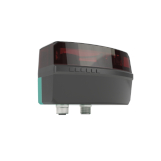Reliable Navigation of Autonomous Vehicles for Intralogistics
R2300 Multi-layer Scanner for 3D Object Detection and Collision Avoidance

The Application
Modern logistics centers that cover several thousand square meters can accommodate more than ten thousand shelves and several million items. Amid such chaos, only the warehouse management system monitors where each item is located. The process of picking an order for delivery is also fully automated. To initiate order picking, the warehouse management system issues a command to transport the corresponding storage rack to the unloading station. Small vehicles such as bots and transport robots move the racks, lifting them out of position and reliably transporting them from the back of the warehouse to the unloading station. The required items are then removed, picked, and packed by an employee. The bot transports the rack back to an empty space.
The Goal
Autonomous vehicles cover many kilometers each day, yet must always function reliably. If manual intervention is ever required, it means shutting down an entire storage area. Preventing collisions between bots, racks, and fallen items is essential for maintaining a smooth workflow. The huge fleets of autonomous vehicles used in this price-sensitive market segment all have the same sensor technology requirements. The devices used must be compact since the bots offer only a small amount of installation space. The sensor must also be rugged enough for use on such vehicles. No safeguards for personnel protection are necessary, but the laser class of the sensors used must not be higher than laser class 1. The detection capability and angular resolution must be especially good. In addition, the sensing range must be wide, and measurement on different planes must be possible to achieve reliable measurement results.
The Solution

R2300 photoelectric sensor
The R2300 multi-layer scanner is perfectly designed for the requirements of such vehicles because it provides reliable collision avoidance data. Capable of measuring on four layers, the scanner monitors the area in front of the vehicle horizontally all the way down to the floor. Combined with the movement of the transport vehicle, the scanner provides spatial monitoring of the vehicle environment and repeatedly detects obstacles. A small light spot and a high-precision angular resolution of 0.1° means that even the smallest structures and contours can be reliably detected.
The 3-D LiDAR sensor also supports navigation of autonomous vehicles and enables reliable collision avoidance due to its high sampling rate and measurement density. Accurate data is delivered via the Ethernet interface to enable application-specific use.
Technical Features:
- Measuring range: 10 m on white (90%), 4 m on black (10%)
- Measuring rate: 50 kHz
- Scanning angle: 100°
- Scan rate: 25/12.5 Hz
- Angular resolution: 0.1°
- Distance measurement accuracy: 30 mm (1 sigma)
- Measuring rate: up to 4,000 pixels per scan
The Benefits
A compact housing design ensures that the 3-D sensor saves space. The device is easily integrated via four M5 tapped holes and a plug connection. During commissioning, the integrated pilot laser functions as a quick alignment aid for the four layers. The sensor delivers 3-D information using the simplest means for mastering complex ambient conditions. The R2300 is a solution for multiple applications—collision avoidance and navigation—in a single device.
At a Glance
- Cost-effective and reliable for object perception in 3D space
- Wide sensing range across four scan planes for collision avoidance and navigation
- Detects small structures and contours due to precise light spot and high angular resolution
- High sampling rate and measurement density
- Accurate data delivered for application-specific use










 +49 621 776-0
+49 621 776-0